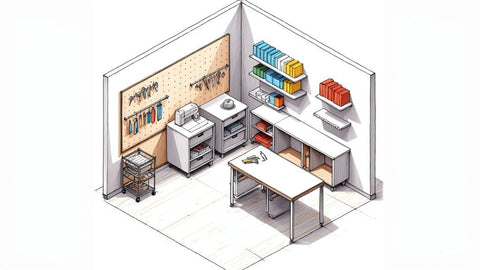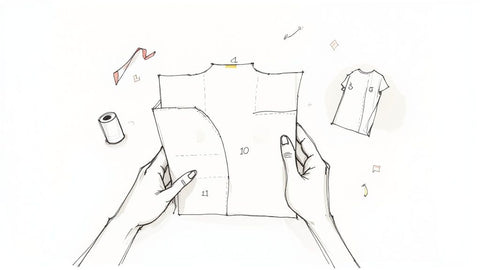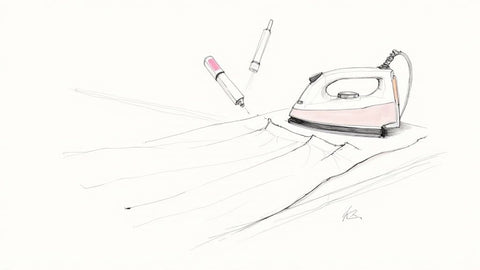A well-organized sewing room is more than just tidy—it's an extension of your creativity, a space where inspiration flows freely without the frustration of searching for misplaced tools. An efficient setup saves precious time, protects your valuable materials, and makes every project more enjoyable from the first cut to the final stitch. A cluttered workspace can stifle productivity, but implementing the right sewing room storage ideas transforms it into a hub of efficiency and inspiration.
This guide presents a curated collection of practical, actionable solutions to help you conquer clutter and build the functional, beautiful workspace you deserve. We will explore specific systems for everything from thread spools and fabric bolts to tiny notions and ribbons. Many of these principles overlap with other creative disciplines; for those with diverse artistic hobbies, exploring these clever art supply storage ideas can provide additional inspiration for your sewing room.
At B-Sew Inn, we understand that a great project starts with a great setup. We are committed to empowering crafters through our custom sewing machine designs, and that commitment extends to helping you create the perfect environment. Our online classes, training, and extensive resources are designed to support every aspect of your craft, including building an organized and inspiring workspace. Let's dive into solutions that will streamline your workflow and reignite your passion.
1. Pegboard Wall Organization System
A pegboard wall organization system is one of the most transformative sewing room storage ideas for turning unused vertical space into a highly functional and visually appealing command center. It consists of a perforated hardboard or metal panel mounted to a wall, featuring a grid of evenly spaced holes. These holes accept a vast array of hooks, shelves, baskets, and holders, allowing you to create a completely customized layout for your essential sewing tools.
The primary benefit of a pegboard is visibility and accessibility. Instead of rummaging through drawers, your most-used items like scissors, rotary cutters, rulers, and thread spools are displayed neatly and within easy reach. This not only saves time but also reduces clutter on your work surfaces, creating a more organized and inspiring environment.
Key Insight: The true power of a pegboard lies in its adaptability. As your projects, tools, and workflow evolve, you can effortlessly rearrange the accessories without any tools, ensuring your storage system always matches your current needs.
How to Implement a Pegboard System
Implementing this system is a tangible project that offers a high return on investment for your organizational efforts.
- Choose Your Material: Decide between traditional hardboard, which is budget-friendly and paintable, or a more durable metal system. For a modern aesthetic, various modular systems are popular choices in many craft rooms.
- Plan Your Layout: Before mounting, lay the pegboard on the floor and arrange your tools. Group similar items together, such as cutting tools, measuring devices, and marking utensils.
- Ensure Proper Installation: Use spacers or a mounting frame to create a small gap between the pegboard and the wall. This space is crucial for allowing the hooks to be inserted and secured properly.
- Customize for Clarity: Consider painting the pegboard to match your room's decor. For an extra layer of organization, you can use a paint marker to outline your tools, creating a visual "home" for each item so you always know where it belongs.
2. Thread Rack and Spool Storage
A dedicated thread rack is an essential component of sewing room storage ideas, designed to keep your collection of spools organized, visible, and ready for use. These systems, ranging from wall-mounted racks to countertop towers, use pegs or dowels to hold each spool individually. This method prevents frustrating tangles, protects thread from dust and damaging UV light, and makes color selection fast and intuitive.
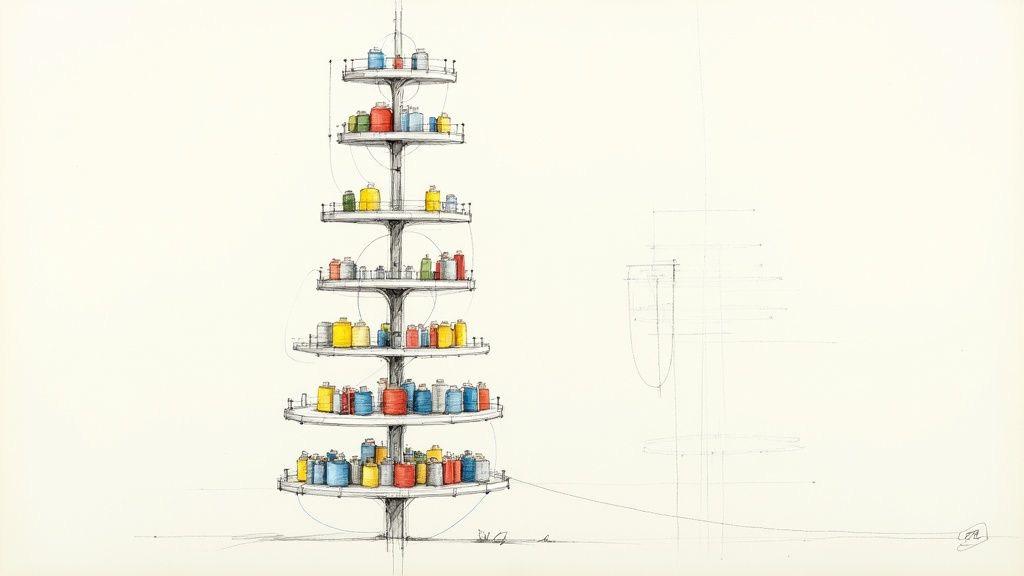
The primary advantage of a proper thread storage system is efficiency. Instead of digging through a tangled box, you can see your entire color palette at a glance, allowing you to find the perfect match in seconds. This visual organization transforms a potential mess into an inspiring display, much like the custom designs and comprehensive resources B-Sew Inn offers to empower crafters in their creative journey.
Key Insight: Effective thread storage does more than just organize; it preserves the integrity of your thread by protecting it from environmental damage, ensuring your stitches remain strong and vibrant over time.
How to Implement a Thread Storage System
Choosing and setting up the right thread storage is a simple way to elevate your sewing space and streamline your workflow.
- Select the Right Type: For large collections, wall-mounted racks save valuable table space. If you have a smaller collection or prefer portability, consider a compact countertop tower or a clear, lidded case.
- Organize Intuitively: Arrange your spools by color family, creating a rainbow effect that is both beautiful and functional. For more advanced sewing, you might also group threads by fiber type (cotton, polyester, silk, etc.) or by brand.
- Pair Up Your Bobbins: Use small drawer organizers or specialized bobbin holders to keep your wound bobbins next to their corresponding thread spools. This simple step eliminates the guesswork of matching them later.
- Consider Placement: Install wall racks near a window with natural light for the most accurate color matching. However, if your room gets intense direct sunlight, use a UV-protective cover or place them on a wall that receives indirect light to prevent fading.
3. Clear Drawer Organizers and Dividers
Clear drawer organizers are a cornerstone of efficient sewing room storage ideas, transforming cluttered, chaotic drawers into perfectly compartmentalized stations for small notions. These systems typically use clear acrylic or plastic trays and dividers, allowing you to create a customized grid inside any standard drawer. This modular approach is ideal for managing small, easily lost items like buttons, snaps, bobbins, seam rippers, and machine needles.
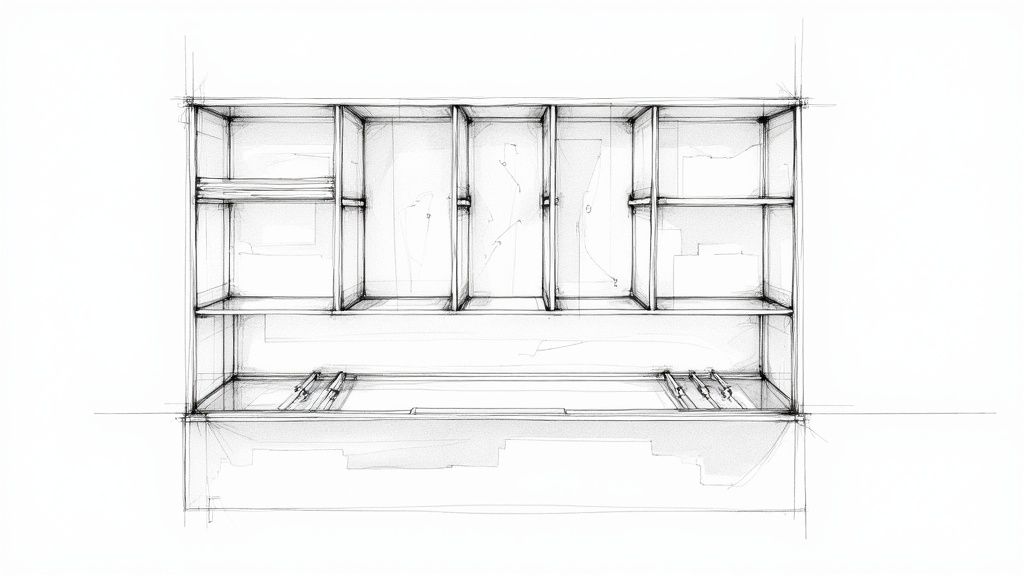
The primary advantage is instant visibility. Instead of digging through a "junk drawer" of mixed supplies, you can see everything at a glance, saving precious time and preventing the frustration of searching for a specific item. By assigning a specific compartment for each type of notion, you maintain order and can quickly assess your inventory, knowing exactly when it's time to restock. This level of organization is essential for maintaining focus on creative projects.
Key Insight: The true benefit of clear organizers is creating a system of "first-order retrievability," a principle championed by professional organizers. Each item has a designated home and is immediately accessible without moving anything else out of the way.
How to Implement Drawer Organizers
Setting up an effective drawer organization system is a quick project with a lasting impact on your daily sewing workflow.
- Measure and Plan: Before purchasing, carefully measure the interior length, width, and depth of your drawers. Plan a layout using a mix of organizer sizes to accommodate different types of supplies.
- Group and Categorize: Dedicate specific organizers to like items. For example, have one section for metal hardware like snaps and hooks, another for elastics and tapes, and a third for marking tools.
- Maximize Vertical Space: In deeper drawers, use stackable, shallow organizers to create layers of storage. Place less frequently used items, like specialty machine feet, in the bottom layer and everyday essentials on top for easy access.
- Secure and Label: Use a non-slip drawer liner underneath the organizers to prevent them from sliding when you open and close the drawer. For ultimate clarity, add small labels to the front edge of each compartment, making it even faster to find what you need.
4. Rolling Storage Carts with Multiple Tiers
A multi-tiered rolling cart is one of the most versatile and adaptable sewing room storage ideas available, offering mobile organization that moves with your workflow. These utility carts, often featuring three or four basket-style shelves on wheels, act as a portable station for your tools and supplies. You can easily roll them from your sewing machine to your cutting table or ironing board, keeping everything you need for a specific task right at your fingertips.
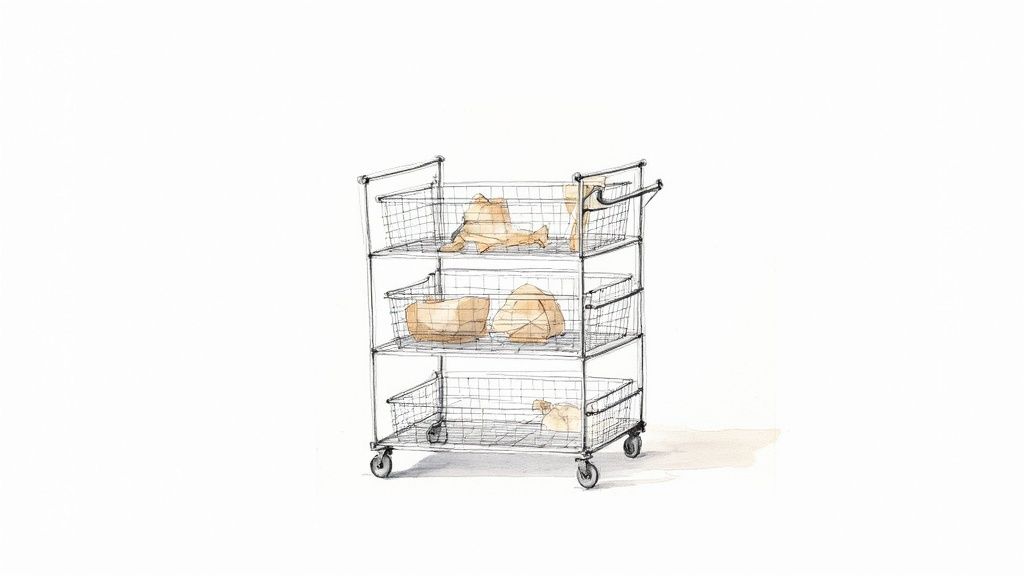
The primary advantage of a rolling cart is its unparalleled flexibility. It is perfect for small spaces where permanent furniture isn't practical, as it can be tucked away in a corner or closet when not in use. This mobility ensures that your most critical supplies are never out of reach, streamlining your process and minimizing interruptions. These organizers have become a staple in modern craft rooms.
Key Insight: Designate a rolling cart as a dedicated "project cart." Load it with the specific fabric, thread, notions, and tools for your current work-in-progress to keep everything contained, portable, and ready to go whenever you have a moment to sew.
How to Implement a Rolling Cart System
Integrating a rolling cart into your sewing room is simple and immediately enhances your efficiency.
- Choose Your Cart: Select a cart that fits your space and needs. The classic metal 3-tier carts are popular for their durability and open design, while some models offer a combination of drawers and shelves for more varied storage.
- Organize with Containers: Use small bins, jars, or drawer dividers on the shelves to corral small items like bobbins, buttons, and clips. This prevents them from getting lost and makes them easy to grab.
- Maximize Vertical Space: Add magnetic strips to the metal sides of the cart to hold scissors, seam rippers, or small metal rulers. You can also use S-hooks to hang tools like rotary cutters.
- Assign a Purpose: Dedicate carts to specific functions. One could be a pressing station holding your iron, spray bottles, and pressing cloths, while another could be exclusively for cutting tools and mats. At B-Sew Inn, we empower crafters with the custom sewing machine designs, online classes, and training they need to bring any project to life.
5. Fabric Storage Solutions (Bolts, Shelving, and Comic Book Boards)
An effective fabric storage system is one of the most crucial sewing room storage ideas for preserving the quality of your textiles while maximizing space. Proper storage protects fabric from wrinkles, dust, and fading, ensuring it's ready for your next project. Methods range from open shelving and traditional bolt storage to specialized organizers, with a particularly popular technique involving acid-free comic book boards.
This approach transforms a chaotic fabric stash into a tidy, visible, and accessible library of materials. Instead of digging through opaque bins or crumpled piles, you can see every pattern and color at a glance, making project planning and fabric selection a far more inspiring process. Organizing your fabric this way makes your collection a beautiful focal point of the room.
Key Insight: The comic book board method, popularized by the quilting community, standardizes your fabric storage. By wrapping yardage around uniform boards, you create neat, stackable "mini-bolts" that fit perfectly on shelves, in drawers, or inside cubbies.
How to Implement Fabric Storage Solutions
Choosing the right fabric storage method depends on your space, collection size, and personal workflow. This guide serves as a how-to for creating a system you can replicate.
- Choose Your Method: For large collections, consider cube shelving systems, which are perfect for displaying fabric wrapped on comic book boards. If you have deep shelves, using shelf dividers can keep stacks from toppling. For smaller stashes or scraps, clear bins or custom containers, like those from the By Annie Contain Yourself pattern, offer a great solution.
- Prepare Your Fabric: For the comic book board method, fold your fabric lengthwise until it's slightly narrower than the board. Wrap it neatly around the acid-free board and secure the end with a pin or a clip.
- Organize Your Collection: Arrange your fabric in a way that makes sense to you. Organizing by color to create a rainbow effect is visually stunning and practical. You can also sort by fabric type (cotton, knit, linen), designer, or project.
- Label for Efficiency: Attach a small tag or sticker to each board or bin noting the yardage and whether the fabric has been pre-washed. This small step saves significant time and guesswork when you start a new project. Always store fabrics away from direct sunlight to prevent fading.
6. Wall-Mounted Magazine Files and Vertical Organizers
Repurposing wall-mounted magazine files and vertical organizers is one of the most clever sewing room storage ideas for managing flat supplies like patterns, interfacing, and reference materials. These systems, commonly found in office supply aisles, are perfectly designed to transform empty wall space into an orderly library for your essential documents and specialty materials. By storing items vertically, they remain uncreased, visible, and easily accessible.
The primary advantage of this method is its efficiency in organizing items that are otherwise awkward to store. Sewing patterns, instruction manuals, stabilizer sheets, and even long rulers can be categorized and filed away neatly, preventing them from getting lost or damaged in drawers or bins. This keeps your workspace clear and ensures you can find exactly what you need without a lengthy search.
Key Insight: This storage solution excels at preserving the integrity of your materials. Storing patterns and interfacing vertically prevents the creases and wrinkles that often result from being folded and stacked, saving you time on pressing and ensuring your supplies are ready to use.
How to Implement a Vertical File System
Setting up a wall-mounted file system is a simple project that yields significant organizational benefits, especially in compact sewing spaces.
- Select Your Organizers: Choose files that match your aesthetic and needs. A minimalist wall-mounted magazine file is a popular choice for patterns. For a more industrial look, wire mesh files are great for holding stabilizer sheets. Acrylic files offer a modern, see-through option for quickly identifying rulers and templates.
- Plan Your Placement: Mount the organizers at or near eye level for easy browsing. Arrange them in a neat row or a grid pattern to maximize storage capacity and create a clean, intentional look.
- Organize and Label: Dedicate each file to a specific category. Group patterns by garment type (dresses, shirts, pants), by brand, or by project. Use clear labels on the front of each file for at-a-glance identification.
- Protect Your Patterns: For frequently used patterns, consider placing the delicate tissue pieces inside page protectors before filing them. This extra step helps them withstand repeated use and keeps smaller pieces from getting lost.
7. Clear Plastic Storage Bins and Stackable Containers
Clear plastic bins and stackable containers are foundational sewing room storage ideas for protecting and organizing fabric, works-in-progress, and bulk supplies. This system provides a dust-proof, moisture-resistant environment while allowing you to instantly identify contents without digging through multiple boxes. The transparency is a game-changer for efficiently finding that specific fabric cut or project kit, saving you precious time and effort.
These versatile containers range from small-part organizers for buttons and bobbins, like those used in professional tailoring shops, to large-capacity bins perfect for storing seasonal fabric collections or bulky batting. Modular, stackable designs maximize vertical space under cutting tables, in closets, or along basement walls, creating a tidy and uniform look.
Key Insight: The true value of clear bins is their ability to create an organized "visual inventory." You can quickly assess your fabric stash or project queue at a glance, which helps prevent duplicate purchases and keeps your creative workflow moving smoothly.
How to Implement a Clear Bin System
Integrating this storage solution is simple and incredibly effective for bringing order to a chaotic collection of materials.
- Categorize Your Items: Before purchasing bins, sort your supplies. Group items by fabric type (cottons, knits, wools), project, season, or color family to determine the sizes and quantities of containers you will need.
- Choose Uniform Sizes: Whenever possible, purchase bins from the same product line. Identically sized containers stack securely and create a more stable, visually cohesive storage wall.
- Label Strategically: Even though the bins are clear, labels are crucial. Place labels on at least two sides of each bin so you can read the contents whether they are stacked high or stored on a deep shelf. You can even tape a photo of the contents to the outside for quick recognition.
- Optimize for Protection: For long-term fabric storage, especially with natural fibers like wool or silk, consider adding silica gel packets inside the airtight bins to absorb any ambient moisture and prevent mildew.
8. Ribbon and Trim Organization Solutions
Specialized organizers for ribbons, trims, and lace are essential sewing room storage ideas that transform tangled messes into a beautifully ordered and accessible collection. These systems are designed to keep long, delicate materials neat, preventing them from creasing, tangling, or getting lost in a drawer. Solutions range from simple DIY dowel rods to sophisticated, multi-tiered commercial dispensers.
The primary advantage of a dedicated ribbon organizer is the ability to see your entire inventory at a glance, making it effortless to select the perfect trim for your project. Many designs, like those seen in professional gift-wrapping stations, allow you to dispense and cut ribbon directly from the spool. This streamlines your workflow and keeps your workspace tidy by eliminating the need to constantly unroll and re-roll materials.
Key Insight: Effective ribbon storage is not just about tidiness; it’s about preservation. By keeping trims neatly wound and secured, you protect them from damage and ensure they are always ready for a flawless application in your sewing projects.
How to Implement a Ribbon Organization System
Implementing a system for your ribbons and trims can be customized to fit any space and budget, from small craft corners to expansive sewing studios.
- Choose Your System: Evaluate your collection. For a few spools, simple solutions like a tension rod inside a cabinet door work well. For larger collections, consider dedicated wall-mounted dowel systems, stackable containers, or clear hanging organizers for shorter lengths.
- Organize Strategically: Before loading your organizer, sort your materials. Group them by color for easy visual matching, by type (satin, grosgrain, velvet), or by width. This pre-sorting makes finding what you need incredibly efficient.
- Secure the Ends: Prevent spools from unraveling by using small binder clips, clothespins, or pins to secure the loose end of each ribbon. This simple step is key to maintaining a neat and tangle-free system.
- Maximize Unused Space: Install dowel or rod systems on the inside of closet doors or underneath shelves. This clever use of vertical and hidden space keeps your collection accessible without cluttering your primary work surfaces.
Sewing Storage Solutions Comparison Table
| Storage Solution | Implementation Complexity 🔄 | Resource Requirements ⚡ | Expected Outcomes 📊 | Ideal Use Cases 💡 | Key Advantages ⭐ |
|---|---|---|---|---|---|
| Pegboard Wall Organization System | Moderate - requires drilling and wall anchors | Affordable ($30-$200) | Flexible, visible tool organization | Craft rooms, tailoring studios, sewing spaces | Customizable layout, easy access, affordable |
| Thread Rack and Spool Storage | Easy to moderate (varies by mounting) | Medium to high cost ($25-$400) | Tangle-free, protected thread with easy selection | Home studios, embroidery, quilting shops | Prevents tangling, thread protection, visible |
| Clear Drawer Organizers and Dividers | Very easy - no installation needed | Moderate cost ($15-$100) | Organized, visible small accessory storage | Drawers for notions, buttons, zippers | Full visibility, prevents mixing, clean look |
| Rolling Storage Carts with Multiple Tiers | Very easy - minimal assembly | Affordable ($30-$150) | Mobile, flexible storage accessible anywhere | Small spaces, renters, project-specific storage | Portable, no mounting, multi-purpose |
| Fabric Storage Solutions (Bolts, Shelving, Comic Book Boards) | Easy to moderate (shelving installation varies) | Variable ($50-$500) | Wrinkle-free, visible, browsable fabric storage | Quilters, fabric collectors | Prevents wrinkles, fabric visibility, stackable |
| Wall-Mounted Magazine Files and Vertical Organizers | Easy - basic wall mounting | Low cost ($3-$15 per file) | Flat, accessible pattern and paper storage | Pattern and instruction storage | Efficient wall use, prevents creasing, affordable |
| Clear Plastic Storage Bins and Stackable Containers | Very easy - no installation | Low to moderate ($5-$50 per bin) | Dust/moisture-proof, stackable, visible storage | Bulk supplies, seasonal fabrics, WIPs | Dust-proof, stackable, durable |
| Ribbon and Trim Organization Solutions | Easy to moderate (depends on mounting) | Moderate ($15-$100) | Tangle-free, visible ribbon storage with dispensing | Ribbon, trim, lace storage | Prevents tangling, direct usage, saves time |
Stitch It All Together with B-Sew Inn
Transforming a cluttered workspace into an efficient, inspiring sewing sanctuary is a journey, not a destination. By implementing the diverse sewing room storage ideas we've explored, you are taking the crucial first step toward reclaiming your creative space and streamlining your workflow. From the incredible versatility of a pegboard wall system to the simple genius of comic book boards for fabric, each solution is a building block for a more productive and enjoyable crafting experience.
The ultimate goal is to create a system where every tool, spool, and fabric scrap has a designated home. Think of how a rolling cart can bring your most-used notions directly to your side, or how clear drawer dividers can end the frustrating search for that specific bobbin or seam ripper. These are not just organizational hacks; they are strategic changes that give you back your most valuable asset: time. More time spent sewing and less time spent searching translates directly into more finished projects and a greater sense of accomplishment.
Key Takeaways for Your Creative Space
The power of these ideas lies in their adaptability. You don’t need a massive room to create an organizational masterpiece. The core principles are about maximizing the space you have, whether it’s vertical, hidden, or mobile.
- Go Vertical: Pegboards, wall-mounted files, and tall shelving units draw the eye upward and free up valuable table and floor space. This is a non-negotiable strategy for smaller rooms.
- Prioritize Visibility: Clear bins, acrylic organizers, and open-front containers are your best friends. When you can see what you have at a glance, you’re more likely to use it and less likely to buy duplicates.
- Embrace Mobility: Rolling carts and portable caddies offer unparalleled flexibility, allowing you to reconfigure your workspace on the fly to suit the demands of any project, big or small.
Ultimately, mastering your sewing room storage is about creating an environment that serves your creativity, rather than hindering it. An organized space reduces mental clutter, allowing your mind to focus on the intricate details of your designs, the precision of your stitches, and the joy of bringing your vision to life.
But a perfectly organized room is just the foundation. The right tools and support are what truly elevate your craft from a hobby to an art form. At B-Sew Inn, we are passionate about empowering your entire creative journey. We don't just sell supplies; we provide the ecosystem you need to thrive. Our custom sewing machine designs are engineered to execute your ideas flawlessly, while our extensive library of online classes and training resources gives you the skills and confidence to tackle even the most ambitious projects. We believe that a great setup, combined with expert support, is the key to unlocking your full potential. Let us help you build not just an organized room, but a launchpad for endless creativity.
Ready to pair your newly organized space with the perfect machine and accessories? Explore our curated selection of storage solutions, innovative sewing machines, and essential crafting tools at B-Sew Inn, and join our B-Creative community for exclusive training and support. Visit us at B-Sew Inn to discover how we can help you stitch your dreams into reality.

